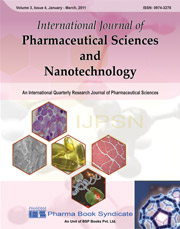Improvement of Dissolution Characteristics of Meloxicam by Complexation with Cyclodextrins
DOI:
https://doi.org/10.37285/ijpsn.2010.3.4.11Abstract
The aim of the present study was an attempt to prepare tablets containing inclusion complexes of meloxicam with β-cyclodextrins and hydroxypropyl-β-cyclodextrin to improve the aqueous solubility of the drug, thus enhances its dissolution rate to show a faster onset of action. Complexation with cyclodextrins has been used as novel approach for designing drug delivery system because of ability for the non-covalent inclusion complexes formation and it has the ability to molecular encapsulate meloxicam into their hydrophobic cavity without the formation of any covalent bonds. Meloxicam complexation with cyclodextrin enhance the drug solubility and dissolution rate. Also cyclodextrins enhance the bioavailability of insoluble drugs by increasing the drug solubility, dissolution and permeability. The carriers used in this study are β-cyclodextrin and hydroxypropyl-β-cyclodextrin. Solid complexes of meloxicam with β-cyclodextrin and hydroxypropyl-β-cyclodextrin were prepared by two different methods namely, Kneading and Co-evaporation techniques. For kneading method, water-methanol-dichloromethane at 2 : 5 : 3 ratio was used as a solvent blend and for co-evaporation techniques, methanol-dichloromethane was used as solvent blend at 2 : 3 ratio. In each case different proportions of drug and carriers at 90 : 10, 75 : 25, 50 : 50, 25 : 75, 10 : 90 were used in the preparation of solid complexes to evaluate the effect of carrier concentrations on the dissolution characteristics. A total of 20 meloxicam solid complexes with different carriers were prepared, found to be fine and free flowing powders. The estimated drug content of the prepared complexes were in the range of 100 ± 5%. The dissolution parameters of T50 and dissolution rate indicated rapid dissolution of meloxicam from the solid complexes when compared with the pure drug and physical mixture. Meloxicam-β-CD (10 : 90) complex gave the highest dissolution rate.
Downloads
Metrics
Keywords:
Meloxicam, β-Cyclodextrin, Hydroxypropyl-β-cyclodextrin, Complexation, Meloxicam solid complexesDownloads
Published
How to Cite
Issue
Section
References
Adel M, Aly Mazen, K Qato and Maharous O Ahmed. Enhancement of dissolution rate and bioavailability of glipizide through cyclodextrin inclusion complex. Pharmaceutical technology. 54, 123-127 (2003).
Challa R, Ahuja A, Ali J, Khar R . Cyclodextrin in drug delivery : An updated review, AAPS Pharm Sci. (02): 329-357, (2005-06).
Chowdary K P R, Nalluri B N, Nimesulide and beta-cyclodextrin inclusion complexes : physicochemical characterization and dissolution rate studies. Drug Dev Ind Pharm. 26: 1217-1220 (2000).
Hirasawa N, Ishise S, Miyata H, Danjo J K. Application of nilvadipine solid dispersion to tablet formation and manufacturing using crospovidome and methyl cellulose as dispersion carriers. Chem Pharm Bull. 52(92): 244-247 (2004).
Jain A C, Adejeje M C. Higroscopicity, phase solubility and dissolution of various substituted sulfobutylether beta-cyclodextrins (SBE) and danazol-SBE inclusion complexes. Int J Pharm. 212: 177-186 (2001).
Jayachandran Babu R, Pandit J K. Cyclodextrin inclusion complxes for oral applications. The Eastern Pharmacist. 37-42, (1996).
K P R Chowdary and Bhogadhi Yashoda, Naga Deepti. Enhamcement of solubility and dissolution rate of nimodipine by complexation with β-Cyclodextrin. The Pharma Review. 126 (2005).
Mitrevej A, Sinchaipanid N, Junyaprasert V, Warintornuwat L. Effect of grinding of β-cyclodextrin and glibenclamide on tablet properties. Drug Dev Ind Pharm. 22: 1237-1241 (1996).
Moyano J R, Arias M J, Gines J M, Perez J I, Rabasco A M. Dissolution behavior of oxazepam in the presence of cyclodextrins : Evaluation of oxazepam dimeb binary system. Drug Dev Ind Pharm. 23: 379-385 (1997).
Palmeri G F, Angeli D G, Giovannucci G, Martelli S. Inclusion of methoxytropate in β-and hydroxypropyl β-cyclodextrins : Comparison of preparation methods. Drug Dev Ind Pharm. 23: 27-37 (1997).
Pose-Vilarnovo B, Perdomo-Lopez I, Echezarreta-Lopez M, Schroth-Pardo P, Estrade E, Torres-Labandeira J J. Improvement of water solubility of sulfamethiazole through its complexation with β-and hydroxypropyl-β-cyclodextrin-Characterization of the interaction in solution and in solid state. Eur J Pharm Sci. 13: 325-331 (2001).
Roger A Rajeswski, Valentino J Stella. Pharmaceutical applications of cyclodextrin. J Pharm Sci. 85; 1142-1144, (1995).
Sajula Baboota and Suraj P Agarwal, Formulation of meloxicam cyclodextrin inclusion complexes incorporated tablets. The Indian Pharmacist. 62-67 (2005).
Satoskar R S, Bhandarkar S D. Analgesic-antipyretic and nonsteroidal anti-inflammatory drugs, Pharmacology and Pharmacotherapeutics. 13th Ed., Vol 1: 139-159 (1993).
Wehrle P, Palmeri GF, Stamm A. Inclusion of vitamin D2 in β-cyclodextrin : Evaluation of different complexation methods. Drud Dev Ind Pharm. 19: 875-885 (1993).






